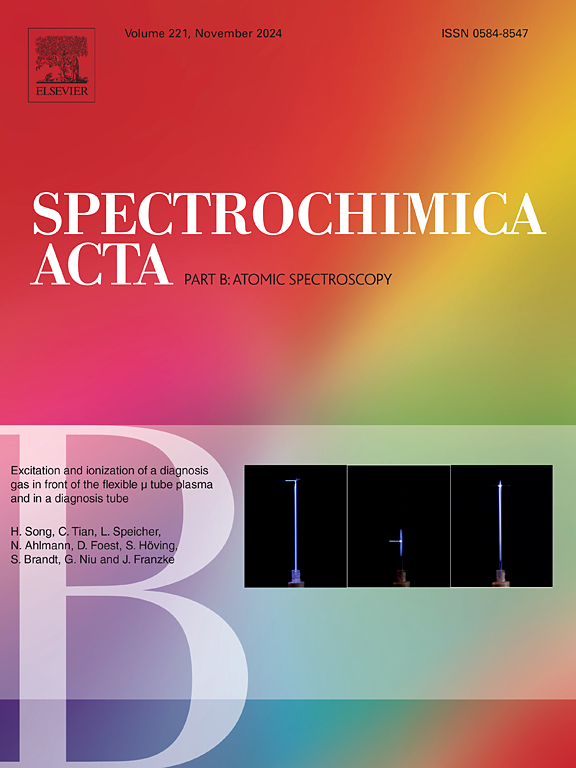Glioma recognition based on polarization laser-induced breakdown spectroscopy and convolutional neural network
IF 3.8
2区 化学
Q1 SPECTROSCOPY
引用次数: 0
Abstract
Currently, the primary treatment for glioma is surgical resection.However, achieving precise resection during surgical process is challenging due to the difficulty in determining glioma boundary. Inadequate resection increases the risk of recurrence, while excessive resection can result in damage to critical functional areas of brain. Therefore, precise identification of glioma boundary holds significant importance. In this paper, we propose utilizing a two-dimensional polarization laser-induced breakdown spectroscopy (LIBS) combined an adaptive iterative re-weighted penalized least squares-two dimensional-convolutional neural network (airPLS-2D-CNN) model for accurate glioma boundary identification. To validate the superiority of this method, its recognition effect is compared with that of eight classification models, including k-nearest neighbor (kNN), partial least squares discriminant analysis (PLS-DA), linear discriminant analysis (LDA), quantitative discriminant analysis (QDA), support vector machine (SVM), artificial neural network (ANN), adaptive boosting (Adaboost) and random forest (RF), which are built based on LIBS polarization spectra and intensity spectra, respectively. The experimental results demonstrate the airPLS-2D-CNN model established using LIBS polarization spectra has the best performance, achieving an accuracy of 90 %, sensitivity of 90 %, specificity of 90 % in the test set.

基于偏振激光诱导击穿光谱和卷积神经网络的胶质瘤识别
目前,胶质瘤的主要治疗方法是手术切除。然而,由于难以确定胶质瘤的边界,在手术过程中实现精确切除是具有挑战性的。切除不充分会增加复发的风险,而过度切除会导致大脑关键功能区域的损伤。因此,胶质瘤边界的准确识别具有重要意义。在本文中,我们提出利用二维偏振激光诱导击穿光谱(LIBS)结合自适应迭代重加权惩罚最小二乘-二维卷积神经网络(airPLS-2D-CNN)模型来精确识别胶质瘤边界。为了验证该方法的优越性,将其与分别基于LIBS极化谱和强度谱构建的k近邻(kNN)、偏最小二乘判别分析(PLS-DA)、线性判别分析(LDA)、定量判别分析(QDA)、支持向量机(SVM)、人工神经网络(ANN)、自适应增强(Adaboost)和随机森林(RF)等8种分类模型的识别效果进行了比较。实验结果表明,利用LIBS偏振光谱建立的airPLS-2D-CNN模型具有最佳的性能,在测试集中实现了90%的准确度、90%的灵敏度和90%的特异度。
本文章由计算机程序翻译,如有差异,请以英文原文为准。
求助全文
约1分钟内获得全文
求助全文
来源期刊
CiteScore
6.10
自引率
12.10%
发文量
173
审稿时长
81 days
期刊介绍:
Spectrochimica Acta Part B: Atomic Spectroscopy, is intended for the rapid publication of both original work and reviews in the following fields:
Atomic Emission (AES), Atomic Absorption (AAS) and Atomic Fluorescence (AFS) spectroscopy;
Mass Spectrometry (MS) for inorganic analysis covering Spark Source (SS-MS), Inductively Coupled Plasma (ICP-MS), Glow Discharge (GD-MS), and Secondary Ion Mass Spectrometry (SIMS).
Laser induced atomic spectroscopy for inorganic analysis, including non-linear optical laser spectroscopy, covering Laser Enhanced Ionization (LEI), Laser Induced Fluorescence (LIF), Resonance Ionization Spectroscopy (RIS) and Resonance Ionization Mass Spectrometry (RIMS); Laser Induced Breakdown Spectroscopy (LIBS); Cavity Ringdown Spectroscopy (CRDS), Laser Ablation Inductively Coupled Plasma Atomic Emission Spectroscopy (LA-ICP-AES) and Laser Ablation Inductively Coupled Plasma Mass Spectrometry (LA-ICP-MS).
X-ray spectrometry, X-ray Optics and Microanalysis, including X-ray fluorescence spectrometry (XRF) and related techniques, in particular Total-reflection X-ray Fluorescence Spectrometry (TXRF), and Synchrotron Radiation-excited Total reflection XRF (SR-TXRF).
Manuscripts dealing with (i) fundamentals, (ii) methodology development, (iii)instrumentation, and (iv) applications, can be submitted for publication.

 求助内容:
求助内容: 应助结果提醒方式:
应助结果提醒方式:


